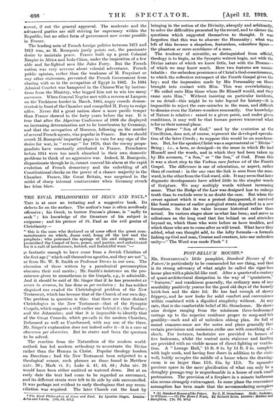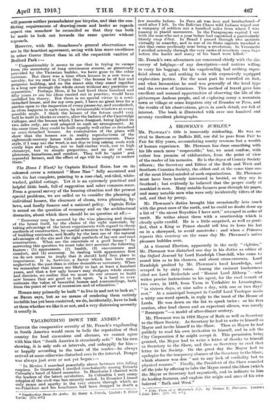POST-BELLUM HOUSES.* Mn. STONEROVSE'S little pamphlet, Standard Renate of the
Future,' is particularly to be commended for one thing, and that is its strong advocacy of what might be called the cigar-box house plan with aplainlid-like roof. After a quarter of a century of quasi-architectural dissipation in the way of "quaintness," " features," and crankiness generally, the ordinary man of any sensibility positively yearns for the good old days of the homely brick-box and the slate lid. He has had enough of showy frippery, and he now looks for solid comfort and convenience within combined with a dignified simplicity without. At any rate, that is the comfortable belief.of Mr. Stonehouse. He shows nine designs ranging from the minimum three-bedroomed cottage up to the superior residence proper to soup-and-fish gentility—each and all of unbroken oblong plan. So full of sound common-sense are the notes and plans generally that certain provisions and omissions strike one with something of a shock. For instance, backstairs are provided to houses of five bedrooms, whilst the central main staircase and landing are provided with no visible means of direct lighting or ventila- tion. A " Lounge Hall," 15 ft. 6 in. by 14 ft. 3 in. complete with ingle nook, and having four doors in addition to the stair- well, boldly occupies the middle of a hOuse where the drawing- room is no larger than 16ft. 6in. by 12ft.• To squander precious space in the mere glorification of what can only be a draughty passage-way is unpardonable in a house of such small pretensions. The provision of a fireplace he a minute bathroom also seems strangely extravagant. In some plans the convenient assumption has been made that the accommodating occupiers • a) ataniard Houses Otto Future. BYO. H. Btodehosse. Jacksdns. 36 Witham.--(2) The Howl Waal. Be Alcbard Bolas. Landon: Redder dad Stoughton. 140. 04. 40t4
will possess neither perambulator nor bieyelea, and that the eon. dieting requirements of drawing-room and leader as regards aspect can somehow be reconciled so that they can both be made to look out towards the same quarter without' reproach.
However, with Mr. Stonehouse's general observations we are in the heartiest.agnsement, seeing with him more excellence in sober Gower Street than in all the coquettish vanities of Bedford Park:-
" Unquestionably it seems to me that in trying to canape from the monotony of long continuous streets, eo generously provided by the Victorian. builder, we have- gone to the other extreme. But there was a time when houses in a row were a novelty, for we read in Utopia that ' the houses be of fair and gorgeous building, and on the street sine they stand together in a long row through, the whole street without any partition or separation.' Perhaps More, if he had lived three hundred and fifty years to see his ideas carried out in practice, would have modified his theory. But there is no special virtue in a semi- detached house, and for my own. part, I have no great hive for a garden open to the inspection of every paseer-by,.anct overlooked, as often happens in such eases, by innumerable windows at every possible angle. I think the houses of the future could very well be built in blocks or courts, after the fashion of the Cambridge Colleges, and the houses which. I have designed, being lighted on two sides only, are well adapted to suoh an arrangement. At the same time, they could be built equally well either as detached or semi-detached • houses. An examination of the plans will show that the houses are in reality reproductions of the eighteenth-century house with modern improvements. Their style, if I may BSS the word, is not due to long raking roofs with costly hips and valleys, nor to half-timber work, nor to high chimneys, but to simple' proportion, and an air of corn. pleteness, homelinesseand comfort. They will be ' quiet ' and reposeful houses, and the effect of age will be simply to mellow them."
The Home I 1Fanf,, by Captain Richard Reins, has on its coloured. cover a. returned " Mons Man " fully accoutred and with tin hat complete, pointing to a rose-eled, red-tiled, white- washed, gabled cottage. Yet it is an extremely practical and helpfulffittle book, full of suggestion art sober common-sense. From a general survey .of the housing situation and the present special problems, we are nailed on to consider the planning of
individual houses, the clearance of slums, town planning, by- laws, and. finally finance and a national policy. Captain Reiss. is sound on the question of economy and on the architectural decencies, about which there should be no question at all :—
" Economy may be secured by the wise planning and design of the house itself, by the choice of the right materials, by taking advantage of the latest experiments with regard to cheap methods of construction, by careful attention to the organisation of building contracts, and finally by the best use of the natural advantages of the site and the right methods of lay-out and road construction. What are the essentials of a good house ? In answering this question we must take into account the following factors: (1) appearance, (2) health, (3) convenience and comfort,. and (4) economy. In dealing with appearance first we-do not mean to imply that it should hold first place in importance. It is, however, a factor which has been more neglected in the past than is either desirable or necessary-. When we remember that houses are likely to last at least a hundred years, and that- a few ugly houses may disfigure whole streets and districts, we realize that we must do- our utmost to build new houses that are good to look upon. 't is hard to over- estimate the value of beautiful homes and surroundings, both from the point of view of recreation and of ednoation."
Houses may primarily be built " to live in and not to look at." as Bacon says, but as no means of rendering them entirely invisible has yet been contrived, we do, incidentally, have to look at them whether we Ifloe it or not, and a very distressing necessity it usually is.




































 Previous page
Previous page